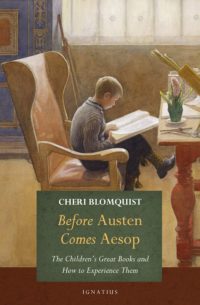Emma Castellino
Review:
 Before Austen Comes Aesop: The Children’s Great Books and How to Experience Them
Before Austen Comes Aesop: The Children’s Great Books and How to Experience Them
by Cheri Blomquist (Ignatius Press, $23.95, 272 pages)
“Nobody else understands it, but I know that William Shakespeare was a black woman.”
This quote, taken from an address Maya Angelou gave in 1977 (The Role of Art in Life), sums up the perfect vitality of the Western literary canon. Hers is the disposition we should desire. At twelve and a half, Angelou understood that Shakespeare had — not just something — everything to say to her. What makes it possible to attend to our inheritance in this way? Should we simply hope to be interested?
Cheri Blomquist, in Before Austen Comes Aesop, argues that the foundations for appreciating the Great Books of our culture are set in childhood. Her notable twist on this familiar recommendation is that reading is not worth much as an ideal if the contents of the books are haphazard. Children’s classics form a large portion of referential material in adult literature. Bypassing these works leaves us, at a later age, floundering in a sea of thematic cultural assumptions which must be painstakingly explicated or altogether missed.
In the first half of her book, Blomquist distills countless contradicting lists of essential children’s literature into “Foundational” and “Important” annotated selections from seven historical eras. Her criteria for selection, which she explains in detail, are based on historical influence, and are as objective as one can reasonably be; she laments how, on occasion, some of her favourites had to be excised. In addition, she provides her own perspective on how to handle certain cases of morally ambiguous material.
The second half of the book is Blomquist’s own study guide for the above material: how to experience the Great Books. Drawing from her extensive teaching experience, she offers flexible options for elementary and secondary students to get the most out of their reading. While I found her general plan of approach cumbersome, she is very clear that not every step should be used for every book, and that students should alternate between leisurely and scholarly reading. Some sections are useful as a technical reference for narrative devices, and the many appendices offer templates for note-taking, question-asking, grading, and planning. The guide itself is proposed simply as an alternative to buying a whole English curriculum.
For Blomquist’s lists alone, this book is worth owning. I was happy to find many of my forgotten childhood favourites there, and discovered many others which I hope to pass on to my own children. A happy conundrum of our generation is the abundance of really beautiful children’s books; these are not to be discounted. But we fumble the test of ages to our own poverty, for “What’s past is prologue” (William Shakepeare, The Tempest).
Emma Castellino, a regular reviewer for The Interim, lives in Hamilton with her husband.




